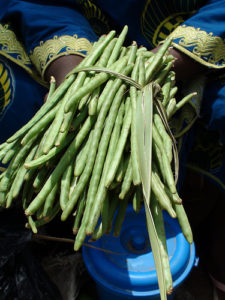Referred to as a “supermarket on a trunk,” moringa is potentially one of the planet’s most valuable plants. Serving not only as a reliable source of diverse foods, moringa also provides lamp oil, wood, paper, liquid fuel, skin treatments, and the means to help purify water. But despite its multiple uses, and well-earned nickname, the tree is relatively unknown to most people in the United States.

Referred to as a “supermarket on a trunk,” moringa is potentially one of the planet’s most valuable plants.
The moringa tree comprises 4 different edible parts: pods, leaves, seeds, and roots. The green-bean looking pods are the most sought-after parts, not only because of their taste – similar to asparagus – but also because they are highly nutritious. They provide a good balance of amino acids and minerals and possess one of the highest vitamin C levels of any tropical vegetable.
The moringa leaves are also an excellent source of nutrition. People commonly boil the tiny leaflets and eat them like spinach. Like the pods, the leaves contain vitamins A and C as well as more calcium than most other greens. These leaves also contain such high levels of iron that doctors frequently prescribe them for anemic patients.
Before fully mature, pods can also be picked for their soft seeds. The seeds can be boiled and eaten like fresh peas, or fried to taste more like peanuts. Seeds can also be pressed for oil that can be used for cooking, medicinal ointments, lamp fuel, or even as an ingredient in soap.
The thick, soft roots are another important food resource, and are usually used to make a condiment similar to horseradish. Boiling roots and shoot tips is also common because of their high-protein content.
Although the moringa tree is best known for its endless supply of food, one of the most innovative uses of the plant has been to treat water and waste water. Researchers at Leicester University, UK, have found that mixing crushed moringa seeds with polluted water help settle silt and other contaminants.
This is highly cost effective because the seeds can replace the expensive imported material usually used for water purification in rural areas. The seed filtered water still needs a final filtration before it is completely drinkable, but the seeds make the process easier and help other water filters last longer.
Moringa trees are also used in agroforestry and mixed cropping because the shade can protect other crops from the sun and, while smoke from household fires can pollute the air, the soft, spongy moringa wood burns cleanly with little smoke or smell, making it a more healthy source of fuel.
Prepared by Elena Davert, research intern with Nourishing the Planet.

Danielle Nierenberg, an expert on livestock and sustainability, currently serves as Project Director of State of World 2011 for the Worldwatch Institute, a Washington, DC-based environmental think tank. Her knowledge of factory farming and its global spread and sustainable agriculture has been cited widely in the New York Times Magazine, the International Herald Tribune, the Washington Post, and
other publications.
Danielle worked for two years as a Peace Corps volunteer in the Dominican Republic. She is currently traveling across Africa looking at innovations that are working to alleviate hunger and poverty and blogging everyday at Worldwatch Institute’s Nourishing the Planet. She has a regular column with the Mail & Guardian, the Kansas City Star, and the Huffington Post and her writing was been featured in newspapers across Africa including the Cape Town Argus, the Zambia Daily Mail, Coast Week (Kenya), and other African publications. She holds an M.S. in agriculture, food, and environment from Tufts University and a B.A. in environmental policy from Monmouth College.








